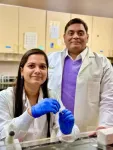(Press-News.org) New research to be presented at this year’s European Congress on Obesity in Venice, Italy (12-15 May) shows that having obesity in childhood is associated with a more than doubling of the risk of later developing multiple sclerosis. The study is by Professor Claude Marcus and Associate Professor Emilia Hagman, Karolinska Institutet, Stockholm, Sweden, and colleagues.
Emerging evidence implies a link between high BMI in adolescence and an increased risk of Multiple Sclerosis (MS). Yet, most studies evaluating this association are cross-sectional, have retrospective design with self-reported data, have used solely genetic correlations, or use paediatric weight data before the obesity epidemic. Therefore, to authors aimed to prospectively evaluate the risk of developing MS in a large cohort of patients with paediatric obesity compared with the general population.
They included patients aged 2 – 19 years with obesity enrolled in the Swedish Childhood Obesity Treatment Register (BORIS) between 1995 – 2020, and a matched comparison group from the general population. Matching criteria included sex, year of birth, and residential area. Exclusion criteria were secondary obesity (eg brain tumours such as craniopharyngioma), and genetic syndromes (eg Prader Willi, morbus Down), and MS diagnosis before 15 years of age (that is, already developing in childhood). MS was identified through Sweden’s National Patient Register. Individuals were followed from obesity treatment initiation, or from 15 years of age if treatment was initiated earlier, until MS diagnosis, death, emigration, or August 2023, whichever came first. The authors computer and statistical modelling to calculate any potential association. Due to previous reported genetic associations of MS, the authors also assessed levels of parental MS which was present in 0.99% in the obesity cohort and 0.68% in the general population comparators.
The data included 21 661 patients (54% boys) from the paediatric obesity cohort with a median age of obesity treatment initiation (behaviour and lifestyle modification) of 11.4 years (years and 102 230 general population comparators. The median follow-up time was 5.6 years, corresponding to median age of 20.8 years in the follow-up population (and 50% of the population were aged between 18 and 25 at the point analysis, with the highest age in the cohort 45 years).
During follow-up, 0.13% [n=28, 18 (64%) female, 10 (36%) male] developed MS in the obesity cohort, whereas the corresponding number in the general population was 0.06% [n=58, 38 (66%) female, 20 (34%) male]. The mean (SD) age of MS diagnosis was comparable between the groups; 23.4 years in the obesity cohort versus 22.8 years in the general population comparators. (see graph in full abstract). The small numbers who developed MS so far means that the study was not sufficiently statistically powered to state the increased risk to females developing MS – however the results follow the general increased risk to females (the estimate ratio of female: male affected by MS in the general population is 4:1).
The crude incidence rate of MS per 100 000 person years was 19.3 in the obesity cohort and 8.3 in the general population cohort. Analyses adjusted for presence of parental MS (heredity) (which was more prevalent in the obesity cohort, as above) revealed that the risk of developing MS was more 2.3 times higher than in the paediatric obesity cohort, with both these findings statistically significant.
The authors say: “Despite the limited follow-up time, our findings highlight that obesity in childhood is associated with an increased susceptibility of early-onset MS more than two-fold. Given that paediatric obesity is prevalent, it is likely to serve as a critical etiological contributor to the escalating prevalence of MS. Paediatric obesity is associated with several autoimmune diseases and the leading hypothesis is that the persistent low-grade inflammatory state, typically observed in obesity, is mediating the association. Understanding these pathways is crucial for developing targeted prevention and intervention strategies to normalise the risk for MS in children and adolescents with obesity.”
They add: “There are several studies showing that MS has increased over several decades and obesity is believed to be one major driver for this increase. Thanks to our prospective study design, we can confirm this theory.”*
“Even though the risk for MS is more than double among children and adolescence with obesity, the absolute risk for MS remains lower than for many other comorbidities associated with obesity. Nevertheless, our study adds to the evidence that obesity in early life increases the risk for a plethora of diseases including MS, and not only the well-known cardiometabolic conditions such as heart disease and diabetes.”
END
Rice University’s Emerging Scholars Program (RESP) has received a five-year, $2.5 million grant from the National Science Foundation. The funding aims to bolster achievements in science, technology, engineering and mathematics (STEM) among students from under-resourced families and communities.
The grant will enable RESP to expand its reach and impact, offering increased support to its scholars via summer tuition scholarships, housing subsidies and research stipends. The number of scholars in the program will increase from 40 to 50 in Summer 2024 and to 60 in Summer 2025.
“Rice ...
A stroke often impacts a person’s ability to move their lower body from the hips down to the feet.
This leads to diminished quality of life and mental health in addition to increased susceptibility to falls. But now, UBC Okanagan researchers are exploring new treatment methods to help bridge the service delivery gap, and recovery outcomes, for patients after a stroke.
“Shortened length of inpatient stays and continued challenges in transitioning back to the community—including poor access to continued stroke rehabilitation services—have resulted in substantial unmet recovery needs,” ...
With nearly 5 million deaths linked to antibiotic resistance globally every year, new ways to combat resistant bacterial strains are urgently needed.
Researchers at Stanford Medicine and McMaster University are tackling this problem with generative artificial intelligence. A new model, dubbed SyntheMol (for synthesizing molecules), created structures and chemical recipes for six novel drugs aimed at killing resistant strains of Acinetobacter baumannii, one of the leading pathogens responsible for antibacterial resistance-related deaths.
The researchers described their model and experimental validation of these new compounds in a study published March 22 in the journal ...
A major global catastrophe could disrupt trade in liquid fuels used to sustain industrial agriculture, impacting the food supply of island nations like New Zealand that depend on oil imports.
A new study in the journal Risk Analysis suggests that New Zealand and other island nations dependent on imported fuel can plan for future emergencies by stepping up their production of biofuel from locally grown crops (like canola) and farming more fuel-efficient crops (like wheat and potatoes rather than dairy).
In the event of a major disruption in liquid fuel imports, results showed that New ...
A research team from New Jersey Institute of Technology is uncovering mysteries surrounding fluids in nanoporous materials, and has been recently awarded a grant from the National Science Foundation (NSF) to support this research.
The research is focused on the elasticity, or compressibility, of fluids in these nanopores. Understanding the elastic properties of fluids has significant implications across multiple disciplines. Engineering applications, geological exploration, materials science and environmental studies ...
BIRMINGHAM, Ala. – A nationwide study of 196 cities shows that housing discrimination from 90 years ago still casts a historical shadow of inequities in colon cancer care today, S.M. Qasim Hussaini, M.D., of the University of Alabama at Birmingham and colleagues at the American Cancer Society and Johns Hopkins School of Public Health report in the journal JCO Oncology Practice.
In the 1930s, the federally sponsored Home Owners’ Loan Corporation, or HOLC, used racial composition to map out residential areas worthy of receiving mortgage loans and those areas to avoid. Neighborhoods ...
Waltham — March 28, 2024 — For patients considering or undergoing plastic and reconstructive surgery (PRS) procedures, using social media to gather information and answer questions can enhance patient empowerment – potentially leading to increased autonomy and better decision-making, reports a study in the April issue of Plastic and Reconstructive Surgery®, the official medical journal of the American Society of Plastic Surgeons (ASPS). The journal is published in the Lippincott portfolio by Wolters Kluwer.
"Our study suggests that connecting to social media is associated with meaningful increases in empowerment for PRS patients, ...
Artificial intelligence excels at sorting through information and detecting patterns or trends. But these machine learning algorithms need to be trained with large amounts of data first.
As researchers explore potential applications for AI, they have found scenarios where AI could be really useful — such as analyzing X-ray image data to look for evidence of rare conditions or detecting a rare fish species caught on a commercial fishing boat — but there's not enough data to accurately train the algorithms.
Jenq-Neng Hwang, University of Washington professor of electrical and computer and engineering, specializes in these issues. ...
DETROIT - A groundbreaking study published in the journal iScience presents crucial insights into the ocular effects of Zika virus infection during pregnancy and offers promising avenues for therapeutic intervention.
Produced by a team of researchers in the Department of Ophthalmology, Visual and Anatomical Sciences at the Wayne State University School of Medicine, the paper, “Targeting ABCG1 and SREBP-2 mediated cholesterol homeostasis ameliorates Zika virus-induced ocular pathology,” provides compelling evidence of the ...
You’ve probably seen nature depicted in art, but how often do you see an artwork hiding in nature?
When they saw the back of a lizard in the Southern Western Ghats, a group of scientists from the Thackeray Wildlife Foundation in India were reminded of Van Gogh’s The Starry Night. As soon as they figured out it was a new species, it was only apt to name it in honour of the famous painter.
“Cnemaspis vangoghi is named for Dutch painter Vincent Van Gogh (1853–1890) as the striking colouration of the new species is reminiscent of one of his most iconic paintings, The ...




